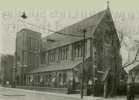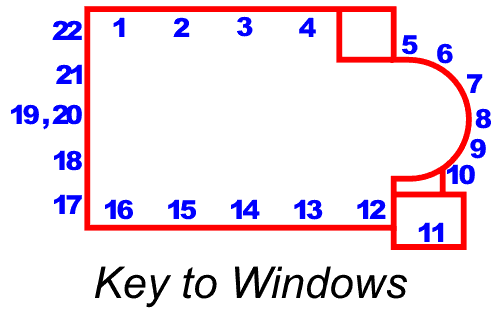For this church:    |
|
 One
of the north One
of the northaisle windows |
Windows 1 to 4
Four pairs of small lights. Five of the eight were filled with stained glass depicting saints. They were possibly the work of Kempe and Company and were a gift from Mrs Mabel Player wife of John Player the cigarette manufacturer. The other three were filled with lozenge shaped Cathedral glass slightly tinted blue and green.
Chancel Apse
Window 5
No definite information available, but this window is thought to have been glazed with Cathedral glass with lozenge pattern leading.
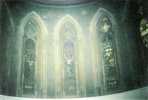 Windows
in the apse Windows
in the apseas in 1963 |
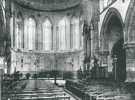 Photograph
of 1910-14 Photograph
of 1910-14showing original apse windows |
Windows 6 to 10
Each of these windows was a tall recessed single pointed light terminating at the springing point of the arch, which was completed with a circular light topped by a small triangle of glazing. Similar glazed spandrels filled the small areas between the lower half of the roundel and the curve of the arch. A photograph taken in 1963 records the three central lights and parts of the other two. The central one (Window 8) depicts the crucifixion and in Window 9 is possibly St George.
These windows were replaced in 1919 as a War Memorial to the men of the parish who died in World War I. Fund raising started in January 1919 and the sum of £310 5s 6d was raised by September of that year. Local dignitaries contributed including John and Mabel Player £10 each, Oliver Hind, Solicitor £2 2s 0d and Thomas Fish Builder £1 1s 0d. A strawberry tea raised £4 10s 0d, but most of the subscriptions were less than £1 and came from the local community.
Two stained glass manufacturers were invited to bid for the work. A Mr Stoddart about whom nothing is known and Gascoyne’s a local company with works in the town on Shakespeare Street. The work was awarded to Gascoyne’s at a cost of £200. The final cost was £292.
Prior to the 1919 replacement the glazing was plain glass set in small squared lead.
Vestries
Window 11
A window in the same style as Windows 1 to 4, but with plain leaded glazing. The room had been divided to form two vestries with one light in each.
South Aisle
Windows 12 to 15
Four pairs as Windows 1 to 4, but with Cathedral glass set in lozenge pattered leaded glazing
Window 16
A single light. Plain leaded glazing
West Windows
All the west windows were re-glazed in 1884 as described below. The cost was met by the ‘vicar and two or three members of the congregation’.
Windows 17 and 22
Two single windows, one at the end of each of the aisles. Each had two lights with a roundel filling the arch. Glazing not identified.
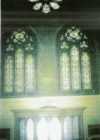 West
end showing West
end showingWindows 18 & 21 |
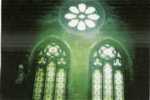 The
rose window above The
rose window abovethe other west windows |
Windows 18 and 21
Set part way up the gable wall these windows were either side of the west door. Much larger then others in the church, each had three pointed lights rising from the sill, the central one extending above those on either side. A large circular light rested on the point of the central light and two smaller circular lights over the outer verticals filled the arch. The larger light had quatrefoil tracery and the smaller ones trefoils. All these lights were glazed with stained glass carrying geometric designs.
Window 19
A large rose window with eight petals and glazing coloured stained glass.
Window 20
This small window was set high in the west gable. It had three lights. The central one being slightly taller than the outer two. Glazing: cathedral glass in lozenge pattern lead.
Clerestory
Three lights of equal size over each arch occupied most of the wall space of the clerestory walls. They were glazed with cathedral glass set in small leaded squares. Having these twelve lights each side made the church very light especially in the late morning when the sunlight came from the south.


